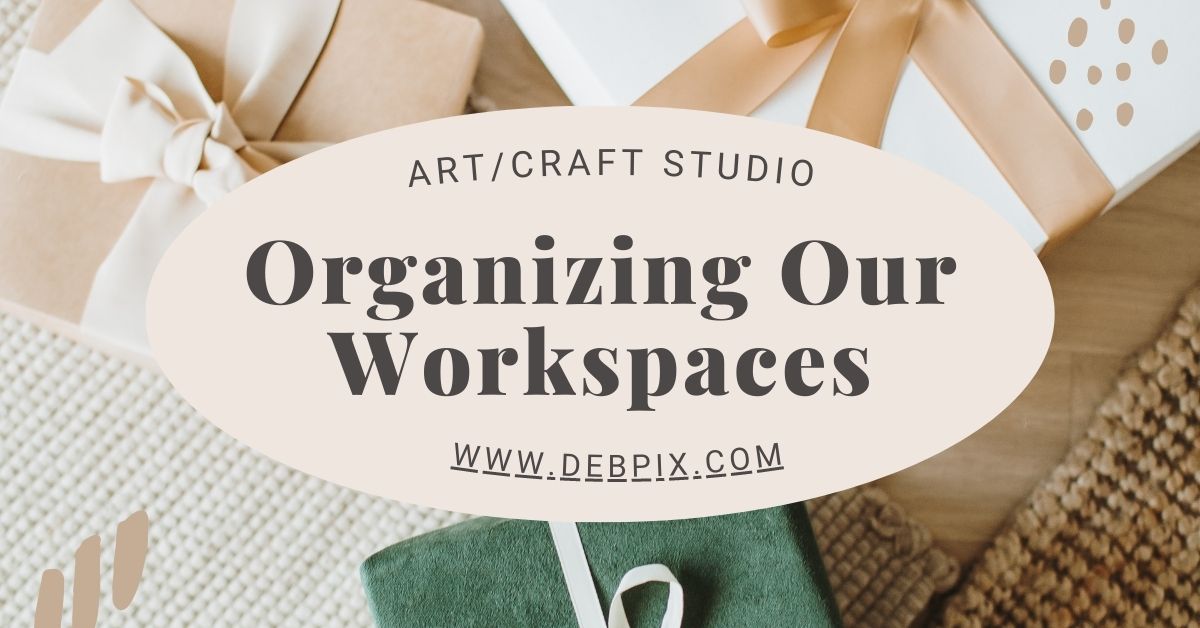We creative types are known for our creativity and imagination, but we also need a well-organized physical workspace to be productive and efficient. A cluttered workspace can hinder creativity and make it difficult to focus on the task at hand. Further, not all artists have the luxury of a large studio or workspace. A small workspace can be challenging to organize, but with a little creativity and the right products, we can make the most of our space and stay organized. In this article, I will discuss some tips and tricks for organizing our workspace, as well as some recommended products to help keep everything in order. And please notice that I am writing this as an artist whose workspace needs some work too — so I include myself as a recipient of this advice to remind myself that I also need to follow it and work on my own solutions.
Table of Contents
- Step 1: Declutter and Clean
- Step 2: Create Zones
- Step 3: Invest in Storage Solutions
- Step 4: Label Everything
- Step 5: Maintain Our Workspace
- Conclusion
- Some Organization Options
Step 1: Declutter and Clean
The first step to organizing our workspace is to declutter and clean. Remove everything from the workspace, including supplies, tools, and artwork. Start by throwing away any items that are broken, outdated, or no longer needed. Consider removing any furniture or equipment that is not essential to our work. Then, sort through the remaining items and decide what we want to keep, donate, or sell. This process can be time-consuming but is essential for creating a clean and organized workspace.
Once we have decluttered, it’s time to clean. Dust and wipe down all surfaces, including our desks, shelves, and storage containers. A clean workspace will not only make us feel better, but it will also reduce distractions and help us focus on our work.
Step 2: Create Zones
Creating zones in our workspace is an excellent way to keep everything organized and easily accessible. Divide our workspace into different zones, such as a painting area, a drawing area, and a storage area. This will help us keep our supplies and tools in their proper place and reduce the amount of time spent searching for what we need.
Step 3: Invest in Storage Solutions
Having the right storage solutions is crucial for keeping our workspace organized. Utilizing vertical solutions — shelves, pegboards, and other wall-mounted storage solutions — is especially helpful for small workspaces. Here are some recommended products:
Storage Cart
A storage cart is a versatile and portable storage solution that can be used for a variety of art supplies. We can easily move it around and store it in a closet or another room when not in use.
Desk and/or Drawer Organizers
Desk and drawer organizers are perfect for keeping small items such as pencils, markers, and paintbrushes in order. They come in various sizes and configurations to fit any drawer size.
Wall-Mounted Shelves
Wall-mounted shelves are an excellent way to save space and keep frequently used supplies within reach. We can use them to store books, reference materials, and even artwork.
Over-the-Door Organizer
An over-the-door organizer is a great space-saving solution that can be used for a variety of supplies, such as paper, canvas, paints, brushes, glue guns, sketchpads — so many items.
Pegboards
Pegboards are a classic organization tool used in many industries. They are perfect for keeping tools and supplies organized and within reach. Pegboards come in various sizes and can be mounted on any wall.
Hanging File Folders
Hanging file folders are a great way to organize our papers and artwork. They can be hung on the wall or stored in a filing cabinet.
Magazine Holders
Magazine holders are a great way to store larger items, such as sketchbooks and notebooks. They can be easily stored on a shelf or in a closet.
Create a Scrap Bin
Create a scrap bin to store leftover materials. This will not only help keep our workspace clean and organized but be an ongoing source of materials that we can use for future projects.
Step 4: Label Everything
Labeling our supplies and storage containers is essential for keeping everything organized. Use a label maker or tape and a marker to label each container, shelf, or drawer. This will help us quickly identify what’s inside and where it belongs.
Step 5: Maintain Our Workspace
Maintaining our workspace is just as important as organizing it. Take a few minutes each day to clean up and put everything back in its proper place. This will prevent clutter from building up and help us stay organized in the long run.
Conclusion
Organizing an artist’s workspace is essential for staying productive and efficient. Start by decluttering and cleaning, then create zones and invest in space-saving storage solutions. Label everything and maintain our workspace to keep it organized in the long run. With these tips and tricks, we can create a clean and organized workspace that will inspire our creativity and help us achieve our artistic goals. I have provided some organization options below to give us some ideas and a head start.
NOTE: In a future post, I will be providing advice for organizing our digital workspaces — potentially more complicated than our physical spaces.
Some Organization Options
- Studio Designs Storage Cart - 4-Drawer Organizer

- Price: $87.81
- Studio Designs Storage Cart - 3-Drawer Organizer

- Price: $87.81
- Whitney Brothers White Cubby Organizer Cabinet

- Price: $769.00
- Bigso Three Drawer Organizer

- Price: $25.99
- Safco Onyx Hanging Desk Organizer - Horizontal

- Price: $44.94
- Itoya ProFolio Art & Desk Organizer - Brown

- Price: $19.99
- Craft Medley Clear Desktop Organizer - 8 Slots

- Price: $7.99
- Craft Medley Organizer Box - 7' W x 11' L

- Price: $9.41
- Craft Medley Organizer Box - 4'

- Price: $5.39
- Canvas Brush Organizer - 22' x 18'

- Price: $32.49
- Safco Powered Onyx Desk Organizer - Monitor Stand

- Price: $63.60
- Craft Medley Organizer Box - 2-1/4' W x 6-3/4' L

- Price: $2.51
- ArtBin Paint Storage Tray

- Price: $29.59
- Like-It Modular Storage Basket - White, Medium

- Price: $20.00
- Tulip Crafter's Storage Tub Kit

- Price: $17.67
- Beka Hanging Easel - With Storage Tray

- Price: $70.00
- Bigso Desktop Accessories - Magazine File

- Price: $14.49
- DYMO LabelManager 160 Portable Label Maker

- Price: $49.34
- Studio Designs Futura Luxe Craft Table

- Price: $236.99
- Paper Rack - 36', Wall Mounted, 3 Roll Unit

- Price: $330.49


















